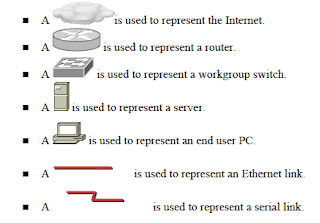In general terms, Network is collection of devices and end systems that connected each other to communicate, share resource and information.
Computer network is funded by The Advanced Research Projects Agency (ARPA) with the design was called "Advanced Research Projects Agency Network" (ARPANET) for the United States Department of Defense. It was the first operational computer network in the world.
Common physical components of a network are:
Computer network is funded by The Advanced Research Projects Agency (ARPA) with the design was called "Advanced Research Projects Agency Network" (ARPANET) for the United States Department of Defense. It was the first operational computer network in the world.
Common physical components of a network are:
- Personal Computers (PC) or other End Systems
- Interconnections such as NIC, Interface, Connector, Network Media / Link
- L2 Devices such as Switches, devices that provide network attachment to the end systems and intelligent switching of the data within the local network
- L3 Devices such as Routers, devices that interconnect networks and choose the best paths between networks
A lot of icons used for interpreting the network diagram
Courtesy of cisco
Courtesy of cisco
Characteristics of a network can be described and compared according to network performance and structure: Speed, Cost, Security, Availability, Scalability, Reliability, Topology.
Topology in networks, there are two types of topologies, physical and logical topology. Physical is the arrangement of the cable that connecting the network devices and logical is the path that the data signal take through the networks.
Basic Physical Topology are bus, ring, and star topology. From that basic, we can create the physical more complex, like: extended ring, full mesh etc, of course we must decide the best that suitable with the networks objective.
Connection to the networks, can also be classified according to the hardware and software technology that is used to interconnect the individual devices in the network, as follows:
Wired Technologies: Twisted-Pair Wire, Coaxial Cable, Fiber Optics
Wireless Technologies: Terrestrial Microwave, Communications Satellites, Cellular and PCS Systems, Wireless LANs using IEEE 802.11, 802.16, Bluetooth etc
Networks are often classified on their scale, scope and purpose, such as Local Area Network (LAN), Wide Area Network (WAN), Metropolitan Area Network (MAN), Personal Area Network (PAN), Virtual Private Network (VPN), Campus Area Network (CAN), Storage Area Network (SAN), etc.
An Internetwork is the connection of two or more distinct computer networks or network segments via a common routing technology. The result is called an internetwork (often shortened to internet). In common use the Internet Protocol now.
There are at least three variants of internetworks, depending on who administers and who participates in them: Intranet, Extranet, Internet.
Many applications available for users in a network environment, some applications are common to use by all users.
Email : Outlook, Eudora, Gmail, Yahoo etc
Web Browser : Firefox, IE, Chrome etc
IM : Yahoo, Gtalk, MSN etc
Database : Sql, File Servers, etc
Collaboration : WebEx, Netmeeting etc
References: Cisco.com, Juniper.net, Wikipedia.org



No comments:
Post a Comment